Water and sewage design: regulatory requirements and
According to what regulatory documents is the water supply and sewage design carried out? How to estimate the required pipe diameter? Is it difficult to calculate the pressure loss in a pipeline with known parameters? What is the slope to lay sewer pipes? In the article we will try to find answers to these and some other questions.
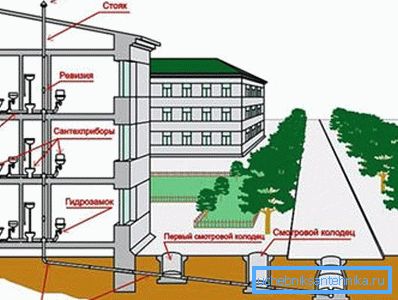
Regulations
Which SNiP for the design of water supply and sewerage networks are currently in force?
The following documents provide the greatest value for the designer:
- SNiP 2.04.02-84, regulating the construction of external water supply.
- SNiP 2.04.03-85, dedicated to the construction of outdoor sewage.
- SNiP 2.04.01-85, which contains requirements for internal water supply and sewage networks.
Useful: specialized instructions for the design and installation of water pipes and sewage of plastic pipes are contained, in addition, in the building codes СН 478-80.
Let's take a look at the key requirements of the listed documents.
SNiP 2.04.02-84
The average daily water consumption per person laid down in the project of the external water supply should correspond to the following table:
| House type | Consumption per person, l / day |
| Baths are missing | 125 - 160 |
| With bathtubs and boilers or columns | 160 - 230 |
| With hot water from the boiler or CHP | 230 - 350 |
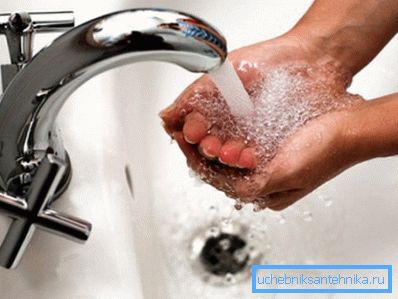
Water consumption for irrigation of crops, maintenance of livestock, poultry, etc. adopted by departmental standards for the relevant industry.
The minimum free pressure in the aqueduct at the input to a separate building at the peak of the discharge should correspond to:
- For single-storey building - 10 meters.
- For high-rise buildings - 10 meters + 4 meters per floor.
The minimum pressure on the water column - 10 meters.
Multi-storey houses in areas with low or one-story buildings are supplied with their own swap.
In the role of water sources can be:
- Rivers and canals.
- Reservoirs, ponds, lakes.
- Underground sources.
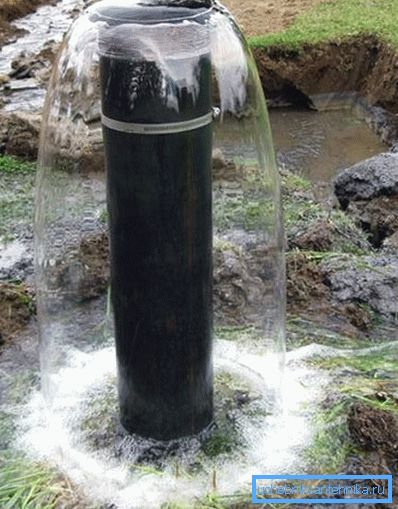
For production needs, the use of treated wastewater is permissible. The use of groundwater, the composition and quality of the corresponding drinking water supply for industrial water supply is prohibited.
Design of outdoor water supply of settlements should be carried out taking into account the possibility of using the drinking water supply system for fire fighting.
SNiP 2.04.03-85
What should be outdoor sewer network? We will deliberately exclude from consideration the requirements for sewage treatment plants and focus on gravity and pressure pipelines for the transport of wastewater.
The smallest diameters of sewer pipes that can be used in external networks are:
| An object | Min diameter, mm |
| Pressure pipe | 150 |
| Intra quarter network (production and household) | 150 |
| Street household network | 200 |
| Rain and common indoor network | 200 |
| Rain and public street network | 250 |
The highest estimated speed of the movement of waste is assumed to be:
- For metal pipes of household sewage - 8 m / s.

- For metal rainwater sewer pipes - 10 m / s.
- For non-metallic (plastic. Concrete, asbestos-cement, ceramic) pipelines for domestic wastewater - 4.
- For non-metallic storm water - 7.
SNiP 2.04.01-85
Now let's take a look at the regulatory requirements for internal sewage and water supply networks contained in the last of the documents under consideration.
The quality and composition of drinking water must fully comply with GOST 2874-82.
Note: the SNiP under consideration is currently in force, but the GOST, to which it refers, was canceled in 1999. Current requirements are set out in the mandatory SanPiN 2.1.4.1074-01.

- The water temperature in the DHW system should not be less than 60 ° C when it is connected to an open heating system and 50 ° C to a closed one. The maximum allowable temperature is 75 C.
Curiously: in reality, this requirement is not met most of the year. In the summer, in the absence of heating (especially in old houses without circulators in the elevators), the water from the highway, reaching the mixer, often cools to 40 degrees or less. In winter, the DHW switches from supply to return pipe only when the supply reaches 90 degrees.
- For kindergartens and nurseries, the temperature of the DHW at the points of water intake should not be above 37 degrees.
- In buildings above 4 floors, the DHW risers should be connected with circulation bridges. The price of non-observance of this requirement is a large non-target consumption of hot water: in the absence of a dismantling, the residents have to drain the water for a long time before it is heated. Section may consist of 3-7 risers.
- The pressure in the DHW system in front of the mixers should not exceed 4.5 kgf / cm2.
Note! In practice, when supplying hot water from a supply line of a route during the heating season, this requirement is impossible in principle: the supply pressure is kept at 5 - 6.5 kgf / cm2.
- In showers with three or more grids, the supply of hot water to the mixers should be organized on at least two sides, making the hot water supply looped off. Otherwise, a sudden change in water pressure can cause burns. The exception is the collector water supply scheme.
- Hydraulic calculation of cold-water systems should be carried out according to the maximum water flow corresponding to the consumption during peak hours.
The following materials can be used for the internal cold water supply and hot water supply networks:
- Polyethylene.
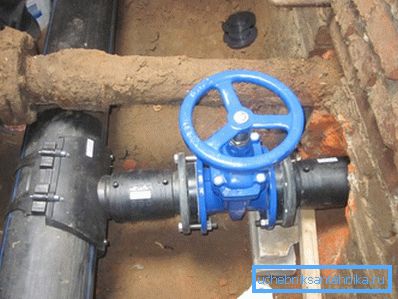
- Polypropylene.
- Polyvinyl chloride
- Polybutene.
- Fiberglass.
- Metal-plastic (multilayer pipes made of aluminum and cross-linked polyethylene).
- Copper.
- Bronze.
- Brass.
- Steel with anti-corrosion protective coatings inside and out.
Pipes must withstand a pressure greater than the worker by 1.5 times, but not less than 6.8 kgf / cm2 at operating temperatures for cold-water and hot water at 20 and 75 degrees, respectively.
The water supply design should provide for the presence of stop valves at the following points:
- On inputs.

- On sections of the ring network (for their independent disconnection during repair).
- On fire stands with the number of fire hydrants at least five.
- On the risers of domestic water supply in homes above three floors.
- On any branches with five or more points of water intake.
- On branches from the main water supply systems.
- On the taps in the apartment, hotel room, on the liner to the flush taps, toilet bowls, water heaters, group sinks and showers.
- Before watering taps.
Captain Evidence suggests: in the latter case, the valve is placed within the building, in a heated room.
Practical recommendations
Let's move to a more practical plane. How is the design of water networks in the construction of private houses with their own hands?
The most typical communications scheme of a private house implies a single input - for cold water. DHW is provided with a boiler or hot-water column; for disposal of sewage, autonomous treatment facilities are used.

Calculate when building is required:
- Peak water consumption.
- The corresponding diameter of the pipeline.
- The pressure drop in this pipeline. At the end of the plumbing fixture, the head should not fall below three, or better, five meters.
- Dimensions of septic tank and filter sump.
Water flow
Its easiest to take from the table below.
| Device type | Water consumption (HWS and HVS), l / s |
| Crane for watering | 0.3 |
| WC with tap | 1.4 |
| Toilet bowl | 0.10 |
| Shower cubicle | 0.12 |
| Bath | 0.25 |
| Washing | 0.12 |
| Washbasin | 0.12 |
With the alleged simultaneous use of multiple devices (for example, shower stall and kitchen sink) costs are added up.

Diameter
In the simplest version, it is also selected according to the table for the estimated peak flow.
| Peak water consumption, l / s | Pipeline control |
| 0.12 | ten |
| 0.36 | 15 |
| 0.72 | 20 |
| 1.44 | 25 |
| 2.4 | 32 |
| 3.6 | 40 |
| 6 | 50 |
For example, in the above case - while using a shower stall and kitchen sink with a mixer - the peak flow rate will be 0.12 + 0.12 = 0.24 liters per second, which corresponds to a pipe of DN15 size.
Please note: plastic pipes are marked with an outside diameter, which is usually about a step larger than the internal one. Thus, a polypropylene pipe with a size of 50 mm has an internal diameter of about 40 mm.
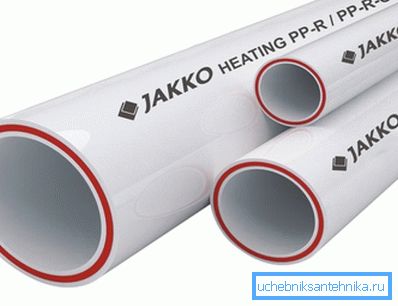
Head pressure
The pressure drop in the pipeline is calculated by the formula H = iL (1 + K).
What do the names of the variables in it mean?
- H - the difference between the heads at the beginning and end of the pipe.
- I - hydraulic slope of the pipeline section.
- L is its length in meters.
- K - coefficient determined by the type of water supply. For domestic drinking water it is taken equal to 0.3.
Where to get the value of the hydraulic slope? From the so-called Shevelev tables containing 1000i values (hydraulic slope for a pipe length of 1000 meters) for various pipe materials, their sizes and flow rates. They are easy to find in any technical library or online.
Reference: the hydraulic resistance of the pipe depends on the roughness of its walls, which is different for different materials. In the case of steel, it additionally changes with the age of the pipeline due to its overgrowing with lime deposits and rust. In addition, the resistance is directly proportional to the flow rate and back to the diameter of the pipe.
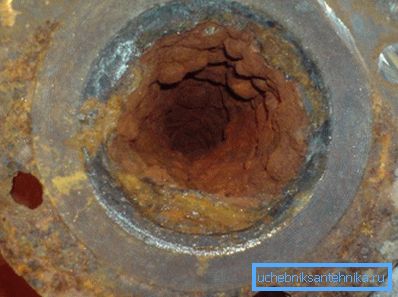
With diameter everything is clear; and what should be the flow rate? The maximum allowable value for drinking water supply is 1.5 m / s; at higher speeds hydraulic noise occurs.
Let's calculate the pressure drop in the new steel pipe DU15 with a length of 43 meters at a flow rate of 1.2 m / s.
- The value 1000i for the specified parameters in accordance with the relevant table is 360.5. By the way, according to the same table, it corresponds to the flow through the pipe at 0.2 l / s. So, in terms of running meter, i = 360.5 / 1000 = 0.3605.
- The formula as a whole takes the form H = 0.3605 * 43 * (1 + 0.3) = 20.15195. The pressure on the end device will be satisfactory if at the inlet it is at least 26.5 meters, which corresponds to a pressure of 2.65 kgf / cm2.
Useful: a typical design of a water well should provide for a check valve at the outlet from the main. Its presence allows not only to drain your water supply, but also to measure the pressure in the route. If the estimate for materials for connection proposed to you does not include the valve DN15, it is better to clarify this point before the work begins.
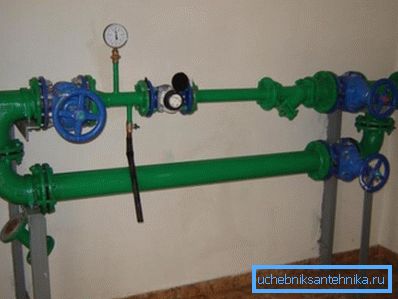
Sewage
It should be laid below the ground freezing level with a constant slope, which is determined by the pipe diameter.
| Diameter | Slope, cm / m |
| 50 | 3.5 |
| 110 | 2 |
| 150 | one |
| 200 | 0.8 |
The volume of the primary septic tank should be equal to at least a three-day volume of wastewater, which is calculated according to the water meter readings or based on the above water consumption rates for different types of houses. In a multi-chamber sump, the volume of the first chamber is taken to be 50% of the total volume.
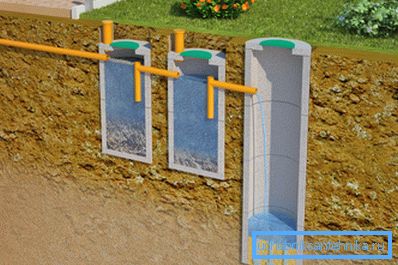
The dimensions of the filter well or filtration fields are calculated depending on the soil absorption capacity, which is taken to be:
- 90 liters per square meter of wetted surface per day for sand.
- 50 - for sandy loam.
- 25 - for loams.
- 10 - for clay.
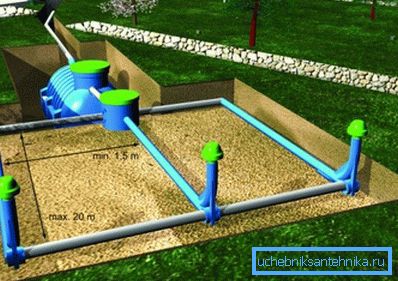
Conclusion
We hope that the above requirements and our recommendations will help the reader in creating the project of sewage and water supply for your own home. Additional materials can be found in the video in this article. Successes!